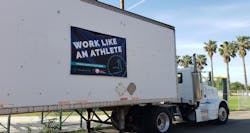Now Loading: The Next Generation of Safe Drivers
High school student Javier Diaz was labeled as a failure in an education system where the necessity of a four-year college degree is propagated from early childhood.
On a path to self-destruction, he enrolled in Dave Dein’s truck-driving course at Patterson High School in Patterson, Calif, a decision that would change his life.
“[Diaz] got so used to be labeled as a failure for so many years in the academic setting. He was growing up to become a really good failure,’ says Dein, who is the CDL coordinator/instructor at Patterson. “His dad came to me about halfway through the year and he’s like, ‘I’m here to shake your hand for saving my son.’ I said, ‘what do you mean?’ He says, ‘before my son took your class, he had no self-esteem. He had no value. He had no purpose. For the first time in his life, he feels like he is somebody. He has something to contribute.’ Literally this kid just kind of took his life and did a 180 with it.”
Diaz became the youngest person hired by one of Patterson High School’s industry partners.
As the vocational/technical worker shortage continues to pose a challenge for industries such as trucking, companies are looking to former employees-turned-educators to promote trades and effectively train the next generation of workers.
For Dein, a foray into trucking education is his proactive way of addressing the gap through turning out a new generation of skilled, safe drivers.
Hitting the Road
Despite a high-salary incentive, the shortage of qualified drivers continues to grow.
According to the American Trucking Associations, the number of for-hire positions open surpassed 50,000 in 2017 and has continued to climb since then.
A lack of routine, significant time away from family and disrespect from other vehicle drivers is the reality of being a trucker, according to professionals. However, the pay exceeds the cons for those who drive, with some companies paying up to $90,000 per year.
Former-hauler Dein saw this shortage and the call to address it. The idea, which began as a non-profit to assist ex-convicts, transformed into helping high school students in Patterson.
Patterson High School is in the center of a distribution “mecca,” home to facilities operated by Amazon, CVS, Grainger, Kohls and other large corporations. The implementation of a trucking vocational path was a no-brainer at the school, which also boasts a supply chain and logistics program for warehouse workers.
“I made a call to the superintendent, and I said I know you guys have this great logistics program, but have you thought about doing truck driving?” Dein says. “I gave him some facts, and he’s said let’s do it. So, we spent a year putting together a curriculum, and we launched the program.”
A Wholistic Approach
Integrating the truck driving program directly into Patterson High School’s curriculum has allowed Dein to better prepare certified students for a career on the road.
Students attend class one hour per day for an entire year, allowing Dein to dive deep into areas such as distracted driving.
This contrasts with two-week truck driving schools that turn out drivers who are often less aware of the hazards and pitfalls of being behind the wheel for long durations.
“We just don’t look at the skills,” Dein explains. “We look at the industry as a whole. We look at what’s going on in the industry. What are the emerging trends? What are the new technologies? We’re growing up in an era with students or just young people that they’re very connected to their phones. We spend a lot of time and I give them visuals of what happens when you do take your eyes off that road for one or two seconds.”
When Dein developed the curriculum, he knew traditional lectures and PowerPoint presentations weren’t going to reinforce concepts in the classroom.
“Technology is all about being relatable. The generation you are working with now, you just can’t give them a textbook and say read this and take a test on it,” he explains. “They want to feel engaged, they want to feel empowered. The use of technology can be a huge benefit in training and providing those skills for students.”
Dein utilizes Worklete, a mobile-ready technology platform for training workers in transportation, shipping and logistics industries to reduce musculoskeletal injuries. The company developed a specialized version of the software to teach students about specific risks associated with the physical demands of the occupation.
“What we’re doing with Patterson is we’re doing a really cool accelerated program where they go through 18 unique, different courses or pieces of curriculum,” describes John Post, Worklete co-founder and chief product officer.
At the end of the semester, the company’s representatives spend a day at Patterson High School to certify students in the program in core competencies.
“That means that they’re certified to go and give coaching and feedback on working techniques to other folks within these industries,” Post says. “A lot of our customers are these big trucking, warehousing and logistics companies. This not only gives these students a very high quality of training, but it’s also making them really desirable.”
This takes some pressure off of companies, trainers and safety managers when they hire workers who are already familiar with certain concepts.
“They get to coach and give feedback on stuff that people are already learning from us,” he says. “Instead of having to teach everything to every single person first hand, they just get to become reinforcers and coaches and give feedback. That’s one really big advantage.”
With industry partners and access to technology such as Worklete, Dein hopes to attract more high school students to vocational careers such as trucking.
Before this happens, however, there needs to be better communication between schools and industry about what types of workers and training is needed. Dein says has been “flooded” with support with the industry since the launch of the program just last year. Other school districts in the area and beyond already have inquired about starting their own initiatives after seeing Patterson’s success in such a short period of time.
“They’re just like whatever you need, we’re here to help,” he says. “So, we started creating partnerships. That’s been a game changer. I think we really need to see more of these proactive type approaches between schools and industry.”
About the Author

Stefanie Valentic
Stefanie Valentic was formerly managing editor of EHS Today, and is currently editorial director of Waste360.
